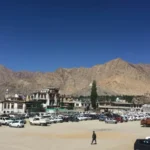A rhetorical bomb was recently dropped by the Foreign Policy magazine which states that China established a whole new village on the territories of Bhutan, in a region historically and globally recognized. In addition, China has done this through a “Gray Zone Invasion,”. This means that China did this without shooting or even attracting any international notice. They did this without causing any military war against Bhutan. This disclosure recalls to what level the Chinese Communist Party is prepared to achieve its global aspirations.
The leaders of China have been working for decades to ensure the rest of the world that the emergence of China is peaceful. China has advocated its intentions that it does not pursue hegemony. Rather China promised that it would simply enjoy peaceful cultural exchanges and trade with other nations. China aims to become a kind and altruistic power.
For the last 70-plus years since the founding of the People’s Republic, #China has never started a war or encroached upon a single inch of foreign soil. China is the only country that has codified #peacefuldevelopment in its constitution.
— Hua Chunying 华春莹 (@SpokespersonCHN) May 25, 2021
The world was faithful to China’s pledge and encouraged China to flourish, failing to recognize that China has adopted an unconventional Gray Zone Plan to expand its territorial claim under Chinese President Xi Jinping‘s leadership, following the ‘that I build upon it, it is mine’ strategy.
The Plight of the South China Sea
In the first place, China tested its Gray Area Operation in the South China Sea. China did the similar on its international overlapping waters; on which there are claims from China and many other South-East Asian countries. China claimed around 3,200 acres of territory by building artificial islands in the South China Sea in the years 2013 to 2015. These artificial islands, as the satellite images show, are militarized with routes, ports, hangars, sensor equipment, planes, radars, and other military installations.
In order to justify its claims over these man-made islands and its waters, China’s Government has created a new city and two administrative districts. Therefore, without involving its neighbours in traditional naval combat, China finished its advance in the South China Sea.
Currently, China claims its territory over more than 90 per cent of the South China Sea, on the other hand, no other country accepts this claim. China is using this claim to justify its coast guard’s strong response to other nations’ regular business activity in the area. China claimed that the United States and the allies carried out military activities on the international water to violate China’s sovereignty.
However, it had minimal impact on the territorial development of the CCP in the South China Sea. Therefore, China chose to operate a similar Himalayan Gray Area Operation.
Bhutan: Small but a Land of Tranquility
A small nation of 800,000 inhabitants, the kingdom of Bhutan is on the eastern edge of the Himalayas. The majority of the people practices Tibetan Buddhism, it’s a lovely and peaceful country. Unfortunately, the state is a source of contention between China and India.
Bhutan is historically well-connected with India and depends on its security on India. While Bhutan has ongoing border tension with China, Bhutan’s stronger neighbour has prevented brutal army warfare. Rather, since the 1980s, two dozen rounds of negotiations have been underway with the aim of resolving their boundary problems peacefully. China launched its Gray-Zone Operation in Bhutan during the 2016 negotiations.
Bhutan and China: A Few Facts
Robert Barnett, a renowned specialist in Tibetan history and politics, reports that from Chinese media and satellite imagery the government has built three new settlements in internationally recognized territories of Bhutan. Situated in Beyul, Gyalaphug is China’s largest town. It is one of the holiest Buddhist settlements in Bhutan.
Currently, Gyalaphug has a population of several hundred and 66 miles of new roads. It has; a small power station, two communist Party administrative centres, a disaster relief warehouse, and five military or police outposts. There is also a major signal tower, satellite reception, a military base, and a maximum of six security sites and outposts.
Win a Territory Without Firing a Single Bullet
Beijing believes that establishing a hamlet in Beyul is not a negative thing because it is the land of China. However, recently, Beijing recognized Bhutan’s claim over Beyul. Barnett discovered that in the late 1990s Beyul was shown as an integral part of Bhutan by the official Chinese 1980s maps, the official Chinese tourist maps and the gazette maps. Additionally, under a 1998 agreement with Bhutan, China pledged to not take “unilateral measures to disrupt the border status quo.”
According to Barnett, the true strategic goal of Chinese land-grabbing is not Bhutan, but India. Since 1990, China has promised to return to Bhutan some territories it controls. However, China is swapping the territory of Bhutan surrounding the Doklam plateau, a region contiguous to India. China believes that Doklam will bring a major edge over the Indian Army to the People’s Liberation Army. That is if China and India are at war.
As a small country, Bhutan has no alternative but to silently bear China’s Gray Zone Invasion. It cannot allow China or India to oppose it. Nonetheless, foreign countries, including the US, shouldn’t remain mute on this subject.
Potential Role of U.S
China’s South China Sea Gray Zone Project and Bhutan show that; it is naïve to believe in the Chinese past assurances of “territorial expansion”. Further, according to analysts, they believe that China’s territorial expansion objectives are quite ambitious. If not controlled, the next target of action for the Grey Area will be other Chinese neighbours (some of the US allies). These nations will have no choice but to finish off becoming vassal states of China without backing from the international community, particularly the US.
Your trusted source for insightful journalism. Stay informed with our compelling coverage of global affairs, business, technology, and more.

![Foreign Policy claims China created a village in recognized territory of Bhutan via "Gray Zone Invasion," revealing CCP's global ambition [ Image via Reuters]](https://southasiatimes.org/wp-content/uploads/2021/05/2022-10-13T035121Z_2066721960_RC220X9GSXS5_RTRMADP_3_BHUTAN-CLIMATE-RACE.webp)



![A perspective captured from Agathi Island, among the ten inhabited islands within the Lakshadweep archipelago [Biju Ibrahim/Al Jazeera]](https://southasiatimes.org/wp-content/uploads/2021/05/IMG_8354-150x150.webp)
Add a Comment